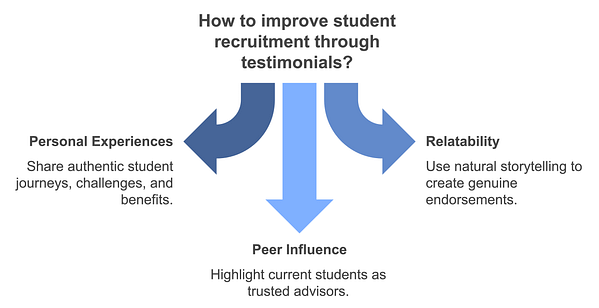Why Student Testimonials Are Your Secret Weapon for Higher Ed Marketing

Influencer marketing is undeniably powerful, with more than 75% of brands now allocating a dedicated budget for influencer campaigns. Yet, higher education marketing still lags behind in effectively leveraging this strategy. With countless institutions vying for the attention of prospective students, finding an authentic way to stand out is more important than ever. The key lies in transforming student testimonials into impactful content, empowering students to become micro-influencers who share genuine experiences that resonate with future applicants.
Student testimonials add unparalleled credibility to an institution’s marketing efforts by bridging the gap between promotional content and relatable, real-life insights. In this blog, we’ll explore why student testimonials are so effective, how they function as influencer content, and how to maximize their impact to drive engagement and boost enrollment.
The Power of Student Testimonials
Authenticity and Trust
Student testimonials are perceived as more credible compared to traditional advertisements because they come from individuals who have experienced the institution firsthand. Unlike highly polished ads, testimonials reflect the genuine voices of real students. This authenticity resonates with prospective students, fostering trust and making the content more impactful. For example, 69% of consumers state that they trust the recommendations that influencers give them for new products or services
Authenticity is crucial for establishing an emotional connection. When prospective students see and hear genuine stories, they are more likely to believe in the institution’s promises and imagine themselves having similar positive experiences. The relatability of these testimonials makes them far more persuasive than traditional promotional materials.
Increased Engagement
- Interaction: Student testimonials prompt followers to interact—whether by asking questions, sharing experiences, or engaging with likes and comments. This interaction fosters a sense of community and encourages prospective students to feel connected to the institution even before enrolling.
- Visibility: Each interaction with a testimonial helps extend its reach. Likes, comments, and shares all help spread the institution’s message to a wider audience. This kind of organic growth is valuable, as it reaches potential students who might not have encountered the institution through traditional advertising.
- Trust Building: Engagement from current students and alumni, through comments or sharing, reinforces the authenticity of the content. Ongoing engagement demonstrates genuine interest and support, building trust with prospective students who are evaluating their options.
Authentic Storytelling
- Personal Experiences: One of the most powerful aspects of testimonials is their ability to share personal journeys. When students talk about the challenges they faced, how they overcame them, and the benefits they gained, it creates a narrative that deeply engages potential applicants. These personal stories help prospective students visualize their own journey.
- Relatability: Unlike traditional ads that often feel scripted, authentic student stories are natural. This relatability makes testimonials so effective—prospective students see real people who were once in their shoes. The natural storytelling approach makes the endorsement feel less like a sales pitch and more like genuine advice.
- Peer Influence: Current students are seen as peers or trusted advisors. When they share how the institution has positively impacted their lives, it carries weight. This peer-to-peer influence bridges the gap between curiosity and action, encouraging prospective students to take the next step.
Leveraging Student Testimonials as Influencers
Social Proof
Student testimonials serve as potent social proof, showcasing positive experiences and reinforcing credibility. When prospective students hear real accounts, it validates the institution’s claims and strengthens its reputation. Strategic curation of testimonials helps prospective students connect with the aspects that matter most—academic support, campus life, or career outcomes. For example, according to a recent study, 92% of prospective students read online reviews and testimonials before making a decision about which institution to attend.
Multi-Format Content for Student Testimonials
- User-Generated Content: Encourage students to use specific hashtags or tag the institution’s social media accounts when sharing experiences. User-generated content adds authenticity and fosters a peer-to-peer community.
- Video Testimonials: Video is particularly effective in bringing student experiences to life. It captures emotions and enthusiasm, making the content more engaging and relatable. Prospective students can see and hear experiences directly, creating an emotional connection.
- Story Highlights: Use Instagram and Facebook Stories to share testimonials in a casual format. Save these as Story Highlights to keep them visible for longer.
- Carousel Posts: Use carousel posts to present multiple testimonials in one post. Each slide can focus on different aspects of student life—academics, activities, and growth—giving prospective students a well-rounded view.
Video is particularly effective in bringing student experiences to life. It captures emotions and enthusiasm, making the content more engaging and relatable. Prospective students can see and hear experiences directly, creating an emotional connection. Once you have video student testimonials, you can slice them up for different social channels and placements. These can be used in PMax campaigns, Instagram Reels, Stories, YouTube Shorts, and long-form videos. This versatility allows institutions to reach their audience effectively across various platforms, each with its unique engagement potential.
Influencer Partnerships
Collaborate with students or alumni who have a strong social media presence to extend reach and enhance credibility. These influencers already have an audience that trusts them. Their endorsements provide an authentic perspective on the institution.
Student influencers can share content, answer questions, and provide an insider’s view of campus life. This engagement enhances credibility and extends reach through authentic peer recommendations.
Student testimonials can also be used in paid advertising. Featuring authentic voices in paid ads opens new opportunities on platforms like TikTok and Instagram. Many institutions fail to leverage these channels effectively, but testimonials in paid placements can boost visibility and engagement.
Before and After Content
Showcasing tangible outcomes, such as achievements and career growth, is impactful. Before and after content lets prospective students see the transformation experienced by current students or alumni. Using visuals to illustrate success stories—such as photos, videos, or infographics—helps prospective students see the real value of attending the institution.
Leveraging B-Roll Footage for Maximum Impact for Student Testimonials
Universities often have a wealth of B-roll footage—campus tours, classroom activities, student interactions, and events—that can be used to create engaging testimonial content. B-roll footage provides visual context, making testimonials more dynamic and visually appealing.
B-roll is especially useful for highlighting aspects of the institution that words alone cannot fully capture. It allows prospective students to see the environment—whether that’s the library, labs, or vibrant events. By pairing visuals with stories, the content becomes more immersive and compelling.
Combining B-Roll with Student Testimonials
Pairing testimonials with engaging b-roll footage helps create a richer, more immersive story. When a student speaks about their experience, b-roll can visually enhance that message. For instance, showing footage of campus scenes while a student talks about campus culture adds visual reinforcement, making the testimonial more relatable.
B-roll also works to maintain viewer interest by breaking up static visuals. This is particularly important when creating longer-form content for landing pages or promotional videos. The seamless blend of testimonials with b-roll footage makes the content more digestible and enjoyable to watch.
Creating an Emotional Connection
B-roll footage helps potential students visualize themselves at the institution. When testimonials are paired with relatable visuals, it fosters an emotional connection that simple text often cannot achieve. Visual cues like landmarks, events, and social gatherings add depth, making it easier for prospective students to imagine themselves in that environment.
Why Student Testimonials Are So Effective in Higher Ed Marketing
Credibility Boost
Student testimonials boost credibility because they come from real students who have experienced the institution firsthand. Prospective students are more likely to trust peer experiences than direct marketing messages. When they hear about a student’s journey—whether it’s overcoming challenges or campus life—it resonates as an authentic narrative. This peer perspective makes testimonials powerful tools for establishing credibility.
Resonance with the Audience
Testimonials create relatable narratives that allow prospective students to visualize themselves in similar situations. Hearing these stories helps prospective students imagine similar successes for themselves. Whether it’s academic success, personal growth, or social experiences, these narratives create emotional resonance and lead to enrollments. For example, according to the Digital Marketing Institute, “A whopping 85% of marketers state that influencer marketing is helping them with their customer acquisition efforts.”
Support for Decision-Making
Choosing a university is a significant decision, and prospective students seek as much information as possible. Student testimonials provide practical insights into what life is really like—covering academics, social experiences, support systems, and career opportunities. These insights help prospective students determine if the institution is the right fit.
How to Maximize the Impact of Student Testimonials
Strategic Placement
For testimonials to be effective, they need to be visible at key touchpoints in the student journey. Place testimonials on high-traffic pages—like the homepage, program-specific pages, and admissions pages. Embedding testimonials on program pages provides prospective students with relevant, firsthand accounts of the experience they’re interested in.
Cross-Platform Promotion
Maximize the reach of testimonials by promoting them across platforms. Testimonials can be featured in social media campaigns, email marketing, and presentations during recruitment events. Instagram Stories provide quick, engaging snippets, LinkedIn posts target professional audiences, and YouTube hosts in-depth videos.
Incentivize Students to Share
Encouraging current students to share their experiences can amplify testimonials. Provide incentives like recognition through “Student Spotlight” campaigns or small rewards. Ambassador programs can also motivate students to regularly share experiences in exchange for perks like merchandise or networking opportunities. Making students feel valued helps create a steady stream of fresh, authentic testimonials.
Student Testimonials Must be a Part of Your Higher Ed Marketing Strategy
Student testimonials are a powerful, authentic, and relatable tool in higher education marketing. They bridge the gap between promotional messaging and genuine student experiences, building credibility and emotional resonance.
By combining student testimonials with b-roll footage, institutions can create richer, more engaging stories that capture the essence of campus life. This type of content strengthens credibility, fosters trust, and enhances the impact of marketing campaigns.
Higher education institutions should leverage student testimonials effectively—through strategic placement, cross-platform promotion, and incentives for participation. Doing so will drive engagement, build trust, and ultimately influence enrollment decisions, ensuring the marketing message resonates with the next generation of students.
Ready to elevate your student marketing strategy? Learn how Campbell Learn can help you leverage authentic student testimonials and impactful content to drive enrollment and engagement. Discover More About Campbell Learn.



